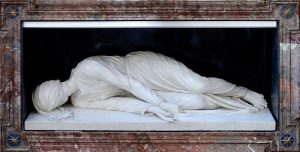About Saint Cecilia:
We do not have much documentation about Saint Cecilia, so much of what we know comes from tradition passed on down throughout the years. She probably lived in the second or third century, and tradition says she died about 177 AD.
Despite not having much written evidence, Saint Cecilia was one of the most revered early virgin martyrs of Rome. She is one of the seven women commemorated by name in the Roman Canon. There is evidence of a church named in her honor dating to the late fourth century. A feast day in honor of Saint Cecilia was celebrated as early as 545. The Feast of Saint Cecilia is celebrated on November 22.
According to tradition, Cecilia was born in a wealthy Roman family and was a Christian by birth. Her family gave her in marriage to Valerius, a pagan nobleman. Cecilia promised to remain a virgin, and she was successful in persuading Valerius to respect her virginity on their wedding night. Later, Valerius was converted to Catholicism along with his brother, Tiburtius.
These two brothers dedicated themselves to burying the Christian martyrs, which was illegal. They were arrested and sentenced to death for refusing to renounce their religion.
Cecilia continued the work of converting people to the Christian faith and of burying the Christian dead, even though it was against the law. Hundreds were baptized through her witness and strength of faith. She planned to have her home preserved as a church after her death. Her refusal to worship false gods and her burying of the dead lead to her arrest. Saint Cecilia was brought to trial and sentenced to death. It took several days for her to die, and it is said that she converted many people who came to care for her as she was dying.
There is a story that Saint Cecilia was said to have heard heavenly music inside her heart when she was forced to marry the pagan Valerian. During her wedding, Cecilia sat and sang to God in her heart. Thus, she was declared to be the patron of musicians. Musical compositions, poems, art, and festivals have grown out of this story. In the Middle Ages, Saint Cecilia became a very popular saint.
Saint Cecilia died lying on her right side with her hands crossed in prayer. The position of her fingers—three extended on her right hand, and one on the left—were her final silent profession of faith in the Holy Trinity, Three Persons in one God. Saint Cecilia was buried in the Catacomb of Saint Callistus.
About the Church of Saint Cecilia in Trastevere:

The Basilica of S. Cecilia was built over the remains of the martyr’s house, which she had originally had intended to turn in to a church.
In 1599 Cardinal Paolo Emilio Sfondrati had the body of St. Cecilia exhumed, which was found in excellent condition (we don’t know if it can be called incorrupt), and commissioned Stefano Maderno to make a marble statue reproducing the exact position in which the body of the Saint was found.
Some of the main works to be highlighted inside the Basilica are: the aforementioned sculpture by Maderno representing the body of the Saint, the ciborium by Arnolfo di Cambio, the “Last Judgment” by Pietro Cavallini , a mosaic in the 9th century basin which represents Jesus blessing, Saints Peter and Paul, Cecilia, Pasquale I with the square nimbus that attests to his living condition at the time of the creation of the mosaic, Valerian, Agata; and the fresco on the vault by Sebastiano Conca “The apotheosis of S. Cecilia”.
Finding the Church of Saint Cecilia in Trastevere:
Address: Piazza di Santa Cecilia, 22, 00153 Roma RM, Italy
Tel/Fax: +39 (06) 45492739
email: Monastero@benedettinesantacecilia.it
Click here for the official website of the Church of Saint Cecilia in Trastevere.
Sources: Benedictine Monastery of Saint Cecilia, Rome.

